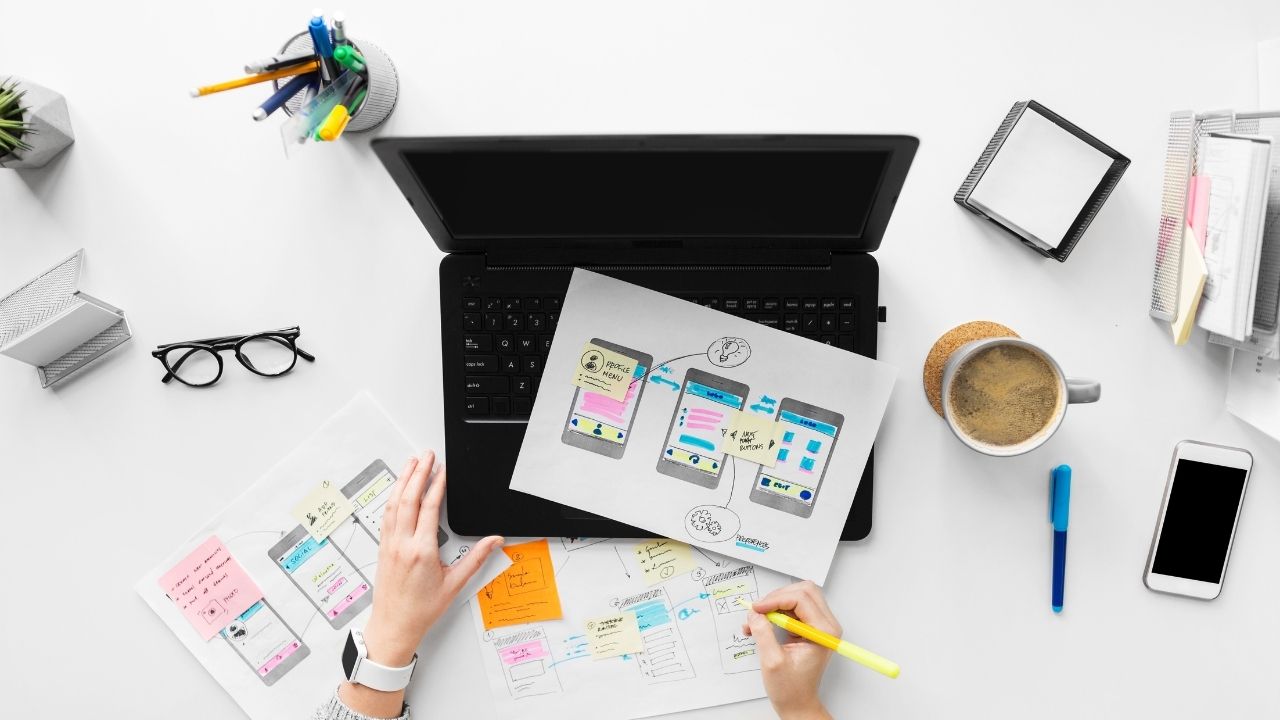Are you looking to create a website that captures your users' attention?
In this article, we will explore the importance of focal points and emphasis in web design.
Discover how visual hierarchy plays a crucial role in directing user attention, and learn techniques to effectively guide your audience.
From using color and contrast to typography and imagery, we will delve into the tools and strategies that can make your website stand out.
Get ready to engage your users like never before!
Key Takeaways
- Visual hierarchy and techniques like size, color, contrast, and placement create a clear and organized layout that guides attention and prioritizes important elements on a website.
- Focal points and emphasis help users easily navigate and stay engaged with the content, and they enhance user satisfaction and drive desired actions.
- Strategic use of visuals, such as color contrast, size variation, and placement, can direct users towards key focal points and improve the visibility of important elements.
- User attention testing, such as eye tracking analysis, can provide insights into visually prominent areas on the website and help optimize design to attract and hold user attention.
The Role of Visual Hierarchy in Web Design
The role of visual hierarchy in web design is to guide your attention and prioritize the most important elements. By using visual hierarchy techniques, designers can create a clear and organized layout that helps you navigate a website with ease.
Through user attention analysis, designers determine which elements need to stand out and grab your attention first. They achieve this by using techniques such as size, color, contrast, and placement. For example, larger and bolder elements tend to catch your eye first, while contrasting colors can create a focal point.

Understanding Focal Points and Their Impact on User Experience
In this discussion, you will explore the importance of visual hierarchy in web design and how it can enhance user engagement.
By understanding how to prioritize elements and guide the user's attention, you can create a more intuitive and engaging user experience.
Through the strategic use of focal points and emphasis, you can ensure that users easily navigate your website and stay engaged with its content.
Importance of Visual Hierarchy
When designing a website, you need to prioritize visual hierarchy to guide your users' attention effectively. The benefits of visual hierarchy are undeniable.
By strategically arranging elements on your webpage, you can create a clear and organized layout that helps users navigate and understand your content effortlessly. Effective use of visual hierarchy ensures that the most important information stands out and grabs the user's attention first. This can be achieved through the use of size, color, contrast, and positioning.
By establishing a clear visual hierarchy, you can direct your users' attention to key areas, such as calls to action or important messages. This not only improves the overall user experience but also increases the chances of achieving your website's goals, such as conversions or engagement.
In short, visual hierarchy plays a crucial role in enhancing user experience and driving desired user actions on your website.

Enhancing User Engagement
To enhance user engagement on your website, make sure to utilize interactive features and encourage social sharing.
By increasing interactivity, you allow users to actively participate and engage with your content. This can include features like quizzes, polls, and interactive videos that keep users hooked and interested.
Additionally, providing opportunities for social sharing allows users to spread the word about your website and its content, ultimately driving more traffic and engagement.
By improving user satisfaction through these interactive features and social sharing options, you create a more immersive and enjoyable experience for your users.
Techniques for Directing User Attention in Web Design
When it comes to directing user attention in web design, color and contrast techniques play a crucial role. By strategically using colors that stand out and creating contrasting elements, you can guide users' eyes to important areas of your website.
Additionally, typography and font choices can greatly impact user experience, as certain fonts are easier to read and can convey different emotions or brand personalities.
Color and Contrast Techniques
Using appropriate color and contrast techniques can greatly enhance your user experience on a website. The strategic use of color psychology can evoke specific emotions and create a visually appealing design. For example, warm colors like red and orange can create a sense of excitement and urgency, while cool colors like blue and green can evoke a feeling of calm and relaxation.

Additionally, understanding visual perception is crucial when selecting color combinations. High contrast between foreground and background colors can improve legibility and make important information stand out. It is important to consider factors such as color blindness and visual impairments when designing a website to ensure that everyone can access and navigate the content effectively.
Typography and Font Choices
Typography and font choices play a significant role in creating a visually appealing and cohesive website design. When it comes to font pairing, it's essential to choose fonts that complement each other and create a harmonious balance. The right combination can enhance the overall aesthetic and improve readability.
Opting for fonts with contrasting styles and weights can help create visual interest and guide the user's attention to important elements. It's crucial to consider readability optimization when selecting fonts for your website. Fonts should be legible across different devices and screen sizes, ensuring that users can easily read and understand the content.
Pay attention to factors like font size, line spacing, and letter spacing to enhance readability. By carefully selecting and pairing fonts, you can create a visually appealing design that not only looks good but also enhances the user experience.
Using Color and Contrast to Create Emphasis in Web Design
To create emphasis in your web design, make use of color and contrast. One effective way to achieve this is by using negative space strategically. By leaving empty space around your focal points, you can draw attention to them and make them stand out.
Another technique to direct user attention is by incorporating motion and animation. By animating certain elements, you can guide the user's eyes towards important information or call-to-action buttons. For example, you can use subtle animations to highlight clickable elements or create movement that leads the user through the page.
Remember to use color and contrast sparingly and purposefully. Too much can be overwhelming and distract from the main focal points.

Typography: A Powerful Tool for Drawing User Attention
Make sure you choose the right font styles and sizes to captivate your audience and guide them through your website. Typography techniques play a crucial role in directing user attention and creating emphasis in web design.
When it comes to font selection, it's important to consider the personality and tone of your website. For a professional and formal look, you may opt for serif fonts like Times New Roman or Georgia. On the other hand, if you want to convey a modern and sleek vibe, sans-serif fonts like Arial or Helvetica can be a great choice.
Additionally, using contrasting font sizes can help highlight important information and draw attention to specific elements on your website. By strategically implementing typography techniques and carefully selecting fonts, you can effectively guide your audience and enhance their overall browsing experience.
The Influence of Imagery and Graphics on User Engagement
Using captivating imagery and graphics can significantly enhance user engagement on your website. Visual storytelling is a powerful tool that captivates users through imagery, creating an emotional connection and drawing them into your content.
By using compelling visuals, you can effectively convey your message, evoke emotions, and leave a lasting impression on your audience.
Additionally, the psychology of color plays a crucial role in influencing user perception and engagement. Different colors evoke different emotions and can impact how users perceive your brand or message. Understanding the psychology of color can help you strategically choose visuals and graphics that align with your desired user experience.
Navigational Design: Guiding Users to Key Focal Points
When designing your website, it's important to guide users towards important areas by strategically placing elements that draw their attention.

One key aspect of achieving this is through effective navigational structure and user interface design. By creating a clear and intuitive navigation menu, you can provide users with a seamless browsing experience, allowing them to easily locate the information they need.
Incorporating visual cues such as color contrast, size variation, and placement can further enhance the visibility of important elements, directing users towards key focal points.
Additionally, employing interactive elements like buttons and call-to-action prompts can encourage user engagement and guide them towards desired actions.
Testing and Analyzing User Attention in Web Design
To effectively analyze user attention in your website design, you should conduct tests that measure how users interact with different elements on the page. Testing techniques, such as eye tracking analysis, can provide valuable insights into where users are focusing their attention.
By using eye tracking technology, you can track and record users' eye movements as they navigate through your website. This allows you to identify the specific elements that capture their attention and those that may go unnoticed.
Eye tracking analysis can reveal which areas of your website are most visually prominent and engaging for users. This information can then be used to optimize your design, ensuring that important content and calls to action are placed in strategic locations to attract and hold user attention.
Frequently Asked Questions
How Does Visual Hierarchy Affect User Experience in Web Design?
Visual hierarchy techniques in web design greatly impact your user experience. By strategically using size, color, and placement, designers can direct your attention to important elements, making your browsing experience more intuitive and engaging.

What Are Some Techniques for Directing User Attention in Web Design?
To direct user attention in web design, consider scrolling behavior and call to action placement. By utilizing these techniques effectively, you can guide users to important content and encourage them to take desired actions on your website.
How Can Color and Contrast Be Used to Create Emphasis in Web Design?
Color and contrast techniques can be employed in web design to create emphasis. By utilizing color psychology and manipulating contrasts, you can effectively direct user attention to specific elements on your website.
What Role Does Typography Play in Drawing User Attention?
Typography techniques and font choices play a crucial role in drawing your attention on a website. Proper use of typography can guide your eyes towards important information and create visual hierarchy, enhancing the overall user experience.
How Do Imagery and Graphics Influence User Engagement in Web Design?
Imagery and graphics play a crucial role in engaging users on your website. By using visual storytelling and interactive elements, you can captivate their attention and create a memorable user experience.
Conclusion
In conclusion, directing user attention in web design is crucial for creating a positive user experience. By utilizing visual hierarchy, focal points, color and contrast, typography, imagery, and navigational design, designers can effectively guide users to key elements on a webpage.
Testing and analyzing user attention further ensures that the design choices are effective. Remember to prioritize the needs of the user and create a visually appealing and engaging design that captures and maintains their attention.

